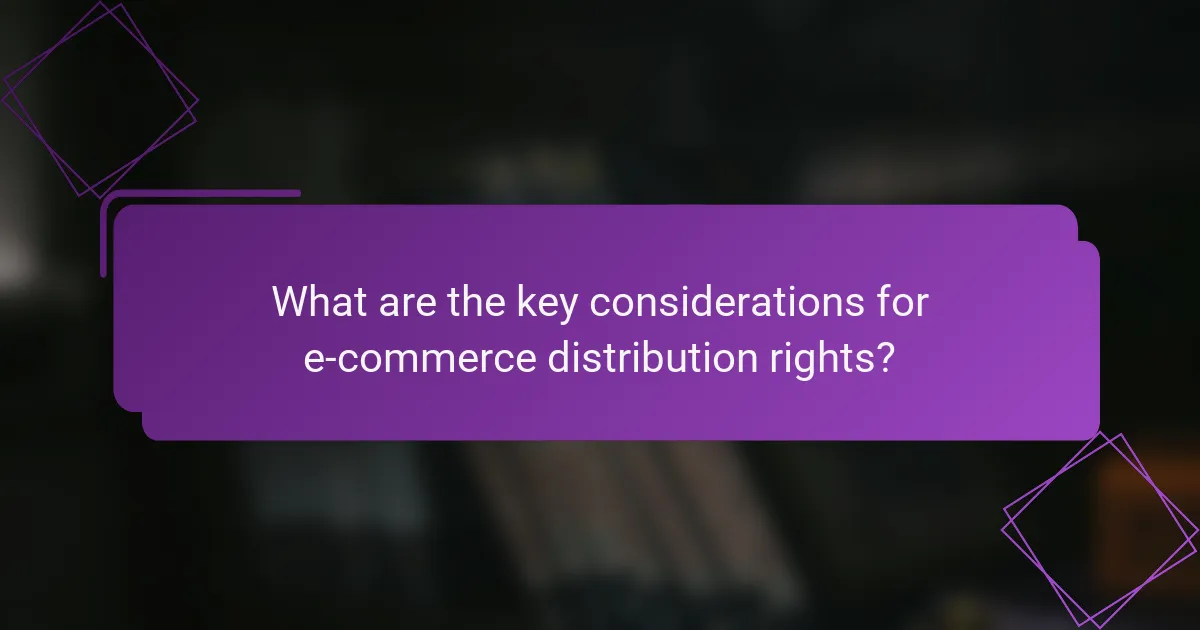Distribution rights are essential legal permissions that allow businesses to sell or distribute products within specific markets. These rights vary in type and come with limitations that can impact marketing strategies, including geographic and time constraints. Additionally, the differences in distribution rights across countries, shaped by local laws and international agreements, highlight the importance of understanding global considerations for successful market expansion.

What are the types of distribution rights?
Distribution rights refer to the legal permissions granted to sell or distribute products in specific markets. Understanding the various types of distribution rights can help businesses navigate their sales strategies and partnerships effectively.
Exclusive distribution rights
Exclusive distribution rights grant a distributor the sole authority to sell a product within a designated territory. This arrangement often leads to a stronger commitment from the distributor, as they are the only ones allowed to market the product in that area.
However, manufacturers must consider that granting exclusivity can limit their ability to reach other potential markets. It’s crucial to weigh the benefits of focused marketing against the risks of reduced market presence.
Non-exclusive distribution rights
Non-exclusive distribution rights allow multiple distributors to sell the same product within a territory. This type of arrangement can increase market penetration and competition among distributors, potentially leading to better pricing and service for consumers.
While non-exclusive rights can expand reach, manufacturers should ensure that their brand remains consistent across different distributors to avoid confusion in the marketplace.
Selective distribution rights
Selective distribution rights involve granting distribution rights to a limited number of distributors based on specific criteria, such as location or expertise. This approach allows manufacturers to maintain control over their brand image while still benefiting from a wider distribution network.
Companies should carefully define the selection criteria and ensure that chosen distributors align with their brand values and standards to maximize effectiveness.
Franchise distribution rights
Franchise distribution rights enable a franchisee to sell a franchisor’s products using the franchisor’s brand and business model. This type of distribution is common in industries like fast food and retail, where brand consistency is crucial.
Franchise agreements often include strict guidelines and support from the franchisor, but franchisees must be prepared to invest in initial fees and ongoing royalties.
Wholesale distribution rights
Wholesale distribution rights allow a distributor to purchase products in bulk from manufacturers and sell them to retailers or directly to consumers. This model often involves lower prices for bulk purchases, benefiting both the wholesaler and the retailer.
Businesses should consider the logistics of managing inventory and the relationships with both manufacturers and retailers to ensure a smooth distribution process. Understanding market demand is key to successful wholesale distribution.

What are the limitations of distribution rights?
Distribution rights come with several limitations that can affect how products are marketed and sold. These limitations can include geographic, time, market, and product constraints, each impacting the scope and effectiveness of distribution agreements.
Geographic limitations
Geographic limitations refer to the specific regions or countries where distribution rights are granted. For instance, a distributor may only have rights to sell a product within a particular country or a defined area, such as the European Union. This can restrict market access and affect sales potential in other regions.
When negotiating distribution rights, it’s crucial to clearly define the geographic scope to avoid conflicts and ensure compliance with local laws. For example, a distributor in Germany may not legally sell products in France unless explicitly permitted.
Time limitations
Time limitations specify the duration for which distribution rights are valid. These agreements can be set for a fixed term, such as one to five years, after which they may need to be renewed or renegotiated. This can create uncertainty for distributors who rely on long-term contracts for stability.
It’s essential to understand the implications of time limitations, as they can affect inventory planning and marketing strategies. A distributor might face challenges if they have to re-evaluate their position or seek new agreements as the expiration date approaches.
Market limitations
Market limitations define the specific market segments or customer types that a distributor can target. For example, a distributor may be restricted to selling to retail outlets and not allowed to sell directly to consumers. This can limit the distributor’s ability to maximize sales opportunities.
When establishing market limitations, both parties should consider the competitive landscape and potential customer base. Clear definitions can help prevent overlap with other distributors and ensure that each party can effectively reach their target audience.
Product limitations
Product limitations specify which products a distributor is allowed to sell under their agreement. This can range from a single product to an entire product line, depending on the arrangement. For example, a distributor may have rights to sell only a specific model of a product, excluding other variations.
Understanding product limitations is vital for distributors to manage their inventory and marketing efforts effectively. They should ensure that the products covered under their rights align with market demand and their sales strategy to avoid missed opportunities.

How do distribution rights vary globally?
Distribution rights differ significantly across countries, influenced by local laws, market practices, and international agreements. Understanding these variations is crucial for businesses looking to expand their reach and navigate legal complexities effectively.
Regional differences in distribution laws
Each region has its own set of distribution laws that can affect how products are marketed and sold. For example, in the European Union, distribution agreements must comply with EU competition law, which emphasizes fair competition and prohibits restrictive practices. In contrast, countries like the United States have more flexible regulations, allowing for a wider range of distribution agreements.
Additionally, some countries may require local representation or partnerships to distribute foreign products, impacting how companies structure their distribution strategies. Businesses should consult local legal experts to ensure compliance with regional laws.
International trade agreements
International trade agreements can significantly influence distribution rights by reducing tariffs and easing market access. Agreements such as the North American Free Trade Agreement (NAFTA) or the Comprehensive and Progressive Agreement for [censured]-Pacific Partnership (CPTPP) facilitate smoother distribution across member countries.
These agreements often include provisions that protect intellectual property rights, which are essential for maintaining control over distribution channels. Companies should stay informed about relevant trade agreements to leverage benefits and avoid potential legal pitfalls.
Local market practices
Local market practices can dictate how distribution rights are exercised, often reflecting cultural preferences and consumer behavior. For instance, in some Asian markets, exclusive distribution agreements are common, while in Europe, a more open distribution model may prevail.
Understanding these practices is vital for effective market entry. Companies should conduct thorough market research to identify local preferences and adapt their distribution strategies accordingly, ensuring alignment with consumer expectations and legal requirements.

What are the key considerations for e-commerce distribution rights?
When managing e-commerce distribution rights, businesses must consider compliance with local regulations, logistics and shipping options, and returns and customer service policies. These factors significantly impact the efficiency and legality of distribution operations across different regions.
Compliance with local regulations
Understanding and adhering to local regulations is crucial for e-commerce distribution rights. Each country has its own laws regarding product distribution, which may include import/export restrictions, taxation, and consumer protection laws. For example, the European Union has specific regulations that govern product safety and labeling.
Businesses should conduct thorough research or consult legal experts to ensure compliance. Non-compliance can lead to fines, product seizures, or even bans on selling in certain markets.
Logistics and shipping options
Logistics and shipping options play a vital role in the distribution process. Companies must evaluate various shipping carriers and methods to determine the most cost-effective and timely solutions. Factors to consider include shipping rates, delivery times, and reliability of carriers.
For instance, using local carriers may reduce shipping costs and delivery times compared to international options. Additionally, businesses should explore fulfillment centers to streamline operations and enhance customer satisfaction.
Returns and customer service policies
Clear returns and customer service policies are essential for maintaining customer trust and satisfaction. E-commerce businesses should establish straightforward return processes that comply with local laws and meet customer expectations. This includes specifying return windows, conditions for returns, and any associated costs.
Providing accessible customer service channels, such as live chat or email support, can further enhance the customer experience. Companies should regularly review and update these policies based on customer feedback and market trends to remain competitive.

How to negotiate distribution rights effectively?
Effective negotiation of distribution rights involves understanding market dynamics, establishing clear agreements, and fostering strong relationships with partners. By focusing on these key areas, you can secure favorable terms that benefit all parties involved.
Understanding market value
To negotiate distribution rights successfully, you must first grasp the market value of the product or service. This includes analyzing competitors, pricing strategies, and consumer demand. Researching similar agreements can provide insight into what constitutes a fair value.
Consider conducting market analysis through surveys or industry reports to gauge the potential revenue and market share. This data will empower you to present a compelling case during negotiations.
Setting clear terms and conditions
Establishing clear terms and conditions is crucial in any distribution rights agreement. This includes defining the scope of rights, duration, territory, and any exclusivity clauses. Be specific about the responsibilities of each party to avoid misunderstandings later.
Drafting a detailed contract that outlines payment structures, performance metrics, and termination conditions can help protect your interests. Regularly reviewing and updating these terms as market conditions change is also advisable.
Building long-term partnerships
Negotiating distribution rights should not only focus on immediate gains but also on building long-term partnerships. Strong relationships can lead to better collaboration, shared resources, and increased market penetration over time.
Engage in open communication with your distribution partners, and consider joint marketing initiatives or training programs to enhance mutual growth. Trust and transparency are key factors in fostering a successful partnership that can adapt to future challenges.

What are the emerging trends in distribution rights?
Emerging trends in distribution rights focus on digital transformation, globalization, and evolving consumer preferences. These trends are reshaping how content is distributed, with an emphasis on flexibility and accessibility across various platforms.
Digital Distribution Models
Digital distribution models are increasingly prevalent, allowing creators to reach audiences directly through online platforms. This shift reduces reliance on traditional intermediaries, enabling faster and more efficient distribution of content.
For example, streaming services like Netflix and Spotify have revolutionized how films and music are consumed, often bypassing conventional distribution channels. This trend highlights the importance of understanding digital rights management to protect intellectual property in a digital landscape.
Global Market Expansion
Global market expansion is a key trend, as content creators seek to tap into international audiences. This requires navigating various legal frameworks and cultural preferences, which can impact distribution rights significantly.
For instance, a film produced in the United States may need different distribution agreements to be released in Europe or Asia, reflecting local regulations and market demands. Understanding these regional differences is crucial for successful global distribution.
Consumer-Centric Approaches
Consumer-centric approaches are shaping distribution rights by prioritizing user experience and accessibility. Content providers are increasingly focusing on how consumers prefer to access and consume media, leading to more tailored distribution strategies.
Subscription models, ad-supported content, and pay-per-view options are examples of how businesses are adapting to consumer preferences. This trend emphasizes the need for rights holders to remain flexible and responsive to changing market dynamics.



